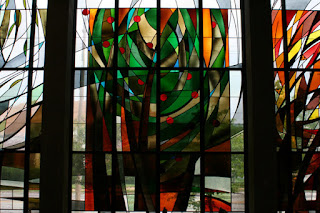Extraordinary Lives in Ordinary Time
Ordinary
Time (which resumed the day after Pentecost) is the longest season of the
Church year and is often dismissed by many people as being, well… ordinary. As
the “Green Season,” Ordinary Time spans those late-winter weeks between the
Baptism of the Lord and Ash Wednesday and the summer and fall months, ending
with the great celebration of Jesus Christ, King of the Universe on the last
Sunday before Advent.
 |
| Summer from the Tree of Life Chapel at First Presbyterian Church, Kirkwood, Missouri designed by Martin Erspamer, O.S.B. |
On
the website of the U.S. Conference of Catholic Bishops, Ordinary Time is
described in this way:
The Sundays and weeks of Ordinary Time… take us through the life of Christ. This is the time of conversion. This is living the life of Christ.
Ordinary Time is a time for growth and maturation, a time in which the mystery of Christ is called to penetrate ever more deeply into history until all things are finally caught up in Christ.Through the days and weeks of Ordinary Time, we hear continuous readings from the prophets and histories of the Old Testament, the letters of the New Testament, and the Gospels. The Church slowly and intentionally moves us through the mysteries and miracles of the life of Jesus. The white and red of the Feasts and Memorials of Mary and the Saints become like individual flowers amid a field of green. Most often, these days go by unnoticed, but they are there nonetheless, offering a sort of commentary on the well-lived Christian life.
In her extended
reflection, The Liturgical Year: The Spiraling Adventure of the Spiritual Life, Benedictine sister Joan
Chittister shares this story:
It was a normal rush-hour day in a New York City airport. Commuters raced down concourses to make quick connections between major incoming flights and local helicopters and business jets that would take them from one small airport to another in time for supper. Men in heavy coats swinging heavy briefcases, and women in high heels loaded down with cumbersome shoulder bags skidded around vendors and carts, corners and counters in a mad rush to reach gates where the doors were already closing…
Suddenly, everyone heard the crash. The fruit stand teetered for a moment and then tilted the fruit baskets off the countertop to the floor. Apples and oranges rolled helter-skelter up and down the concourse. Then the girl behind the counter burst into tears, fell to her knees, and began to sweep her hands across the floor, searching for the fruit. “What am I going to do?” she cried. “It’s all ruined. It’s all bruised. I can’t sell this!” One man, seeing her distress as he ran by, stopped and came back.
Seeing how frantic she was, he got down on the floor with the girl and began putting apples and oranges back into baskets. And it was then, as he watched her sweep the space with her hands, randomly, frantically, that he realized that she was blind. “They’re ruined,” she kept saying.
The man took forty dollars out of his wallet, pressed it into her hand. “Here,” he said as he prepared to go, “here is forty dollars to pay for the damage we’ve done.” The girl straightened up. She began to grope the air, looking for him now. “Mister,” the bewildered blind girl called out to him, “Mister, wait…” He paused and turned to look back into those blind eyes. “Mister,” she said, “are you Jesus?”
In these first
days after Pentecost, the Church remembers dozens of men and women who have
something to teach us about living extraordinary lives in ordinary time. As
varied as the times and places in which they live, these figures, like all the
saints, help us to understand what it means to “be like Jesus.” Alongside the
monks and nuns, priests and popes, are “ordinary” saints, who were not
consecrated religious or clerics, who also lived extraordinary lives and prove
that is possible “to be other than those around us who live to exploit here
rather than to grow in the light of the hereafter”: Saint Euprhosyne of Polotsk
(d. 1172; May 23); Saint William of Rochester/Perth (d. 1201; May 23); the twin
brothers, Donation and Rogation (d. ca. 304; May 24); Saint Agatha Yi So-Sa (d.
1831; May 24); Saint Mariana of Quito, Ecuador (d. 1645; May 26); BlessedMargaret Pole (d. 1541; May 28) ; Saint Ferdinand of Castile (d. 1252; May 30);
and Saint Joan of Arc (d. 1431; May 30).
In her Pulitzer
Prize-winning book, Pilgrim At Tinker Creek, Annie Dillard wrote:
The shadow’s the thing. Outside shadows are blue, I read, because they are lighted by the blue sky and not the yellow sun. Their blueness bespeaks infinitesimal particles scattered down inestimable distances. Muslims, whose religion bans representational art as idolatrous, don’t observe the rule strictly; but they do forbid sculpture, because it casts a shadow. So shadows define the real. If I no longer see shadows as “dark marks,” as do the newly sighted, then I see them as making some sort of sense of the light. They give the light distance; they put it in its place. They inform my eyes of my location here, here O Israel, here in the world’s flawed sculpture, here in the flickering shade of the nothingness between me and the light.
A challenge for
these ordinary days might be to learn the saints’ stories and listen to them,
find courage in their witness, and remember that what was possible for them, is
possible for us.




Comments
Post a Comment